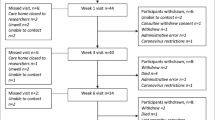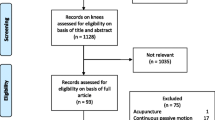Key summary points
To investigate the association between additional weekend rehabilitation and functional outcomes among different age groups.
AbstractSection FindingsAfter matching 129,583 pairs of cases, a significantly higher correlation was found between patients who had received weekend rehabilitation and improved physical function at discharge compared with those who had not received weekend regarding function in transferring, walking, and stair climbing at discharge, as compared with patients who did not (odds ratio [95% confidence interval]: 1.17 [1.15–1.19], 1.17 [1.15–1.2], and 1.06 [1.03–1.08], respectively).
AbstractSection MessageWeekend rehabilitation was significantly associated with improved physical function; to optimise rehabilitation therapy given limited healthcare resources, low demand activities can be more effective in older age groups, whereas high demand activities should be aimed at younger age groups.
Abstract
Purpose
Rehabilitation after hip fracture surgery is crucial for improving physical function. Additional rehabilitation over the weekend or after working hours is reportedly associated with improved physical function; however, this may not apply to an aging population, including patients aged > 90 years. This study aimed to investigate the association between additional weekend rehabilitation and functional outcomes in different age groups.
Methods
This study analyzed a cohort of patients aged ≥ 60 years who had hip fractures and were operated on from 2010 to 2018. Data were extracted from a nationwide multicentre database. Functional outcomes at discharge were compared between patients who underwent rehabilitation on weekdays only and those who underwent rehabilitation on both weekdays and weekends. The patient groups were selected using propensity score matching analysis. Furthermore, a subgroup-analysis was conducted on patients in their 60 s, 70 s, 80 s, and 90 s.
Results
A total of 390,713 patients underwent surgery during the study period. After matching, each group comprised 129,583 pairs of patients. Patients who underwent weekend rehabilitation exhibited improved physical function in transferring, walking, and stair climbing at discharge, as compared with patients who did not (odds ratio [95% confidence interval]: 1.17 [1.15–1.19], 1.17 [1.15–1.2], and 1.06 [1.03–1.08], respectively). In subgroup analysis, except for stair climbing, the positive association between weekend rehabilitation and patient function was observed across all age groups.
Conclusion
Weekend rehabilitation was significantly associated with improved physical function. Given the limited healthcare resources, high-demand activities such as stair climbing may be reserved for younger age groups to optimise rehabilitation therapy.



Similar content being viewed by others
Data availability
The Diagnosis Procedure Combination (DPC) database cannot be made available to comply with data governance agreements with the respective management authorities. The data can only be obtained through applications to authorised research institutions.
References
Takusari E, Sakata K, Hashimoto T, Fukushima Y, Nakamura T, Orimo H (2021) Trends in hip fracture incidence in Japan: estimates based on nationwide hip fracture surveys from 1992 to 2017. JBMR Plus 5:e10428. https://doi.org/10.1002/jbm4.10428
Dyer SM, Crotty M, Fairhall N, Magaziner J, Beaupre LA, Cameron ID et al (2016) A critical review of the long-term disability outcomes following hip fracture. BMC Geriatr 16:158. https://doi.org/10.1186/s12877-016-0332-0
González-Zabaleta J, Pita-Fernandez S, Seoane-Pillado T, López-Calviño B, Gonzalez-Zabaleta JL (2016) Comorbidity as a predictor of mortality and mobility after hip fracture. Geriatr Gerontol Int 16:561–569. https://doi.org/10.1111/ggi.12510
Veronese N, Maggi S (2018) Epidemiology and social costs of hip fracture. Injury 49:1458–1460. https://doi.org/10.1016/j.injury.2018.04.015
Chen M, Du Y, Tang W, Yu W, Li H, Zheng S et al (2022) Risk factors of mortality and second fracture after elderly hip fracture surgery in Shanghai. China J Bone Miner Metab 40:951–959. https://doi.org/10.1007/s00774-022-01358-y
Handoll HH, Cameron ID, Mak JC, Panagoda CE, Finnegan TP (2021) Multidisciplinary rehabilitation for older people with hip fractures. Cochrane Database Syst Rev 11:CD007125. https://doi.org/10.1002/14651858.CD007125.pub3
Yang TI, Kuo YJ, Huang SW et al (2023) Minimal short-term decline in functional performance and quality of life predicts better long-term outcomes for both in older Taiwanese adults after hip fracture surgery: a prospective study. J Orthop Surg Res 18:791. https://doi.org/10.1186/s13018-023-04278-3
Lee MC, Chang CW, Shih SL, Huang SJ, Tsauo JY, Hsiao KL, Chien MY (2022) Efficacy and cost-effectiveness analysis of post-acute care for elderly patients with hip fractures. J Formos Med Assoc 121(8):1596–1604. https://doi.org/10.1016/j.jfma.2022.01.002
Peiris CL, Taylor NF, Shields N (2012) Additional Saturday allied health services increase habitual physical activity among patients receiving inpatient rehabilitation for lower limb orthopedic conditions: a randomized controlled trial. Arch Phys Med Rehabil 93:1365–1370. https://doi.org/10.1016/j.apmr.2012.03.004
Peiris CL, Shields N, Brusco NK, Watts JJ, Taylor NF (2013) Additional Saturday rehabilitation improves functional independence and quality of life and reduces length of stay: a randomized controlled trial. BMC Med 11:198. https://doi.org/10.1186/1741-7015-11-198
Brusco NK, Shields N, Taylor NF, Paratz J (2007) A Saturday physiotherapy service may decrease length of stay in patients undergoing rehabilitation in hospital: a randomised controlled trial. Aust J Physiother 53:75–81. https://doi.org/10.1016/s0004-9514(07)70039-9
Hasebe K, Momosaki R, Sawabe M, Chono M, Sawaguchi A, Kasuga S et al (2018) Effectiveness of weekend physical rehabilitation for functional recovery in geriatric patients with hip fracture. Geriatr Gerontol Int 18:1143–1146. https://doi.org/10.1111/ggi.13326
Quan H, Sundararajan V, Halfon P, Fong A, Burnand B, Luthi JC et al (2005) Coding algorithms for defining comorbidities in ICD-9-CM and ICD-10 administrative data. Med Care 43:1130–1139. https://doi.org/10.1097/01.mlr.0000182534.19832.83
Yamana H, Moriwaki M, Horiguchi H, Kodan M, Fushimi K, Yasunaga H (2017) Validity of diagnoses, procedures, and laboratory data in Japanese administrative data. J Epidemiol 27:476–482. https://doi.org/10.1016/j.je.2016.09.009
Austin PC (2009) Balance diagnostics for comparing the distribution of baseline covariates between treatment groups in propensity-score matched samples. Stat Med 28:3083–3107. https://doi.org/10.1002/sim.3697
Roche JJ, Wenn RT, Sahota O, Moran CG (2005) Effect of comorbidities and postoperative complications on mortality after hip fracture in elderly people: prospective observational cohort study. BMJ 331:1374. https://doi.org/10.1136/bmj.38643.663843.55
Kjaervik C, Gjertsen JE, Engeseter LB, Stensland E, Dybvik E, Soereide O (2021) Waiting time for hip fracture surgery: hospital variation, causes, and effects on postoperative mortality: data on 37,708 operations reported to the Norwegian Hip fracture Register from 2014 to 2018. Bone Jt Open 2:710–720. https://doi.org/10.1302/2633-1462.29.BJO-2021-0079.R1
Farrow L, Hall AJ, Ablett AD, Johansen A, Myint PK (2021) The influence of hospital-level variables on hip fracture outcomes. Bone Jt J 103-B:1627–1632. https://doi.org/10.1302/0301-620X.103B10.BJJ-2021-0461.R1
Ogawa T, Yoshii T, Moriwaki M, Morishita S, Oh Y, Miyatake K et al (2020) Association between hemiarthroplasty vs total hip arthroplasty and major surgical complications among patients with femoral neck fracture. J Clin Med 9:3203. https://doi.org/10.3390/jcm9103203
Charlson ME, Pompei P, Ales KL, MacKenzie CR (1987) A new method of classifying prognostic comorbidity in longitudinal studies: development and validation. J Chronic Dis 40:373–383. https://doi.org/10.1016/0021-9681(87)90171-8
Mahoney FI, Barthel DW (1965) Functional evaluation: the Barthel Index: a simple index of independence useful in scoring improvement in the rehabilitation of the chronically ill. Md State Med J 14:61–65
Shigematsu K, Nakano H, Watanabe Y (2013) The eye response test alone is sufficient to predict stroke outcome–reintroduction of Japan Coma Scale: a cohort study. BMJ Open 3:e002736. https://doi.org/10.1136/bmjopen-2013-002736
Rosenbaum PR, Rubin DB (1983) The central role of the propensity score in observational studies for causal effects. Biometrika 70:41–55. https://doi.org/10.1093/biomet/70.1.41
Tang VL, Sudore R, Cenzer IS, Boscardin WJ, Smith A, Ritchie C et al (2017) Rates of recovery to pre-fracture function in older persons with hip fracture: an observational study. J Gen Intern Med 32:153–158. https://doi.org/10.1007/s11606-016-3848-2
Beckmann M, Bruun-Olsen V, Pripp AH, Bergland A, Smith T, Heiberg KE (2022) Recovery and prediction of physical function 1 year following hip fracture. Physiother Res Int 27:e1947. https://doi.org/10.1002/pri.1947
Ni M, Brown LG, Lawler D, Bean JF (2017) Reliability, validity, and minimal detectable change of four-step stair climb power test in community-dwelling older adults. Phys Ther 97:767–773. https://doi.org/10.1093/ptj/pzx039
Funding
None.
Author information
Authors and Affiliations
Contributions
The authors confirm their contributions to the paper as follows: study conception and design: TO, RO, and HS; data collection: KF; analysis and interpretation of results: TO, RO, HS, HS, and MTK; manuscript draft preparation: TO, RO, HS, HS, and MTK; supervision: MTK, TY, and TJ. All authors reviewed the results and approved the final version of the manuscript.
Corresponding author
Ethics declarations
Conflict of interest
The authors have no conflict of interest to declare. All authors have read and agreed to the published version of the manuscript.
Ethical review committee statement
The study protocol was approved by the institutional review boards of Tokyo Medical and Dental University (M2000-788-14).
Informed consent
This study was approved by the institutional review board (M2000-788), and the requirement for the acquisition of informed consent from individual patients was waived because the data were anonymised.
Additional information
Publisher's Note
Springer Nature remains neutral with regard to jurisdictional claims in published maps and institutional affiliations.
Supplementary Information
Below is the link to the electronic supplementary material.
Rights and permissions
Springer Nature or its licensor (e.g. a society or other partner) holds exclusive rights to this article under a publishing agreement with the author(s) or other rightsholder(s); author self-archiving of the accepted manuscript version of this article is solely governed by the terms of such publishing agreement and applicable law.
About this article
Cite this article
Ogawa, T., Onuma, R., Sagae, H. et al. Association between additional weekend rehabilitation and functional outcomes in patients with hip fractures: does age affect the effectiveness of weekend rehabilitation?. Eur Geriatr Med (2024). https://doi.org/10.1007/s41999-024-00980-5
Received:
Accepted:
Published:
DOI: https://doi.org/10.1007/s41999-024-00980-5




